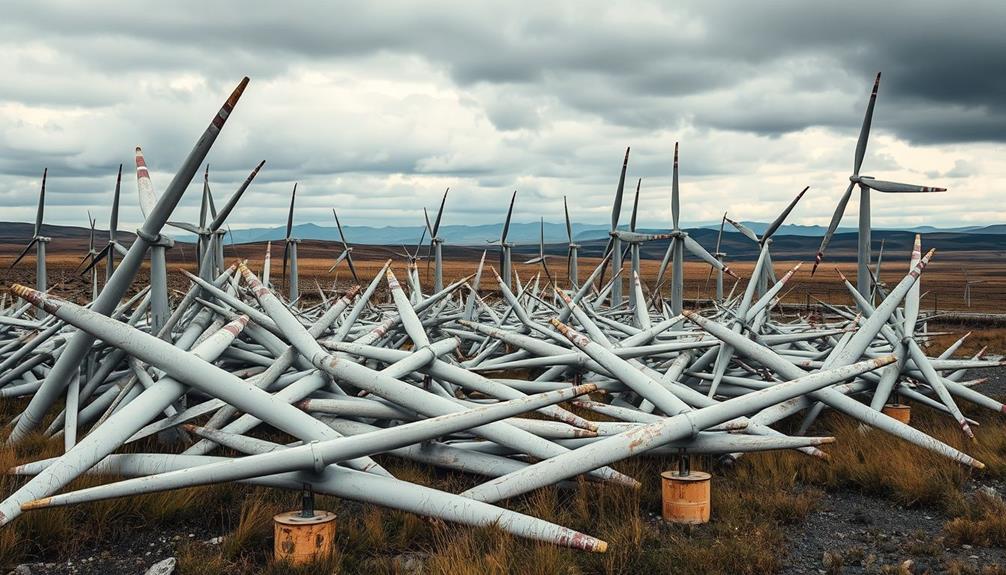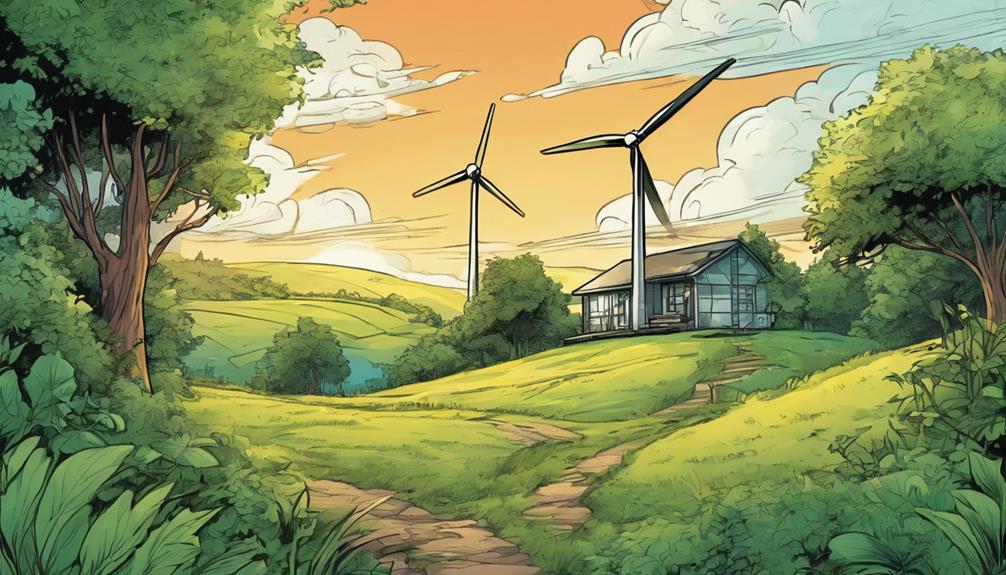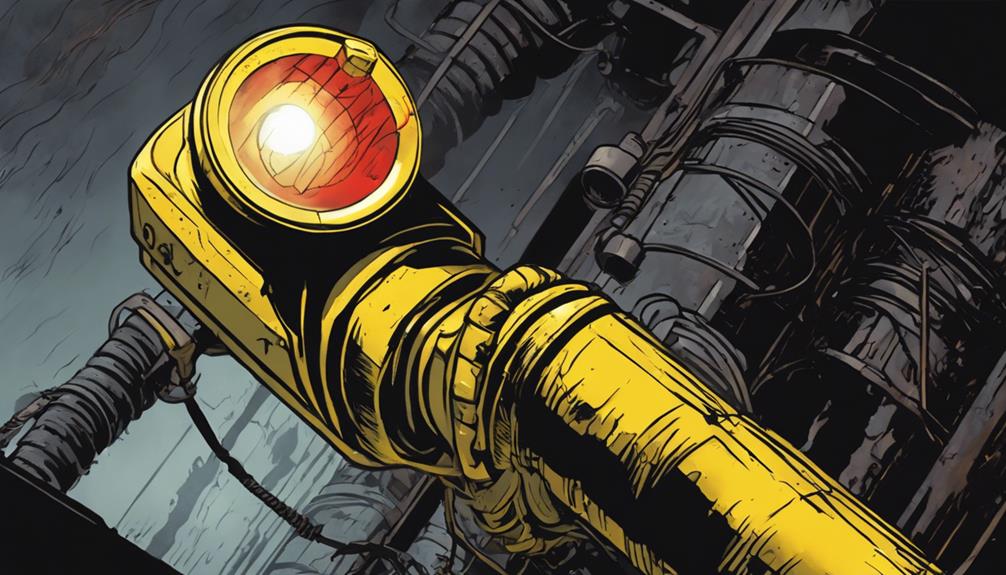When wind turbine blades reach the end of their lifespan, they often end up in what's called a "blade graveyard." Many are stockpiled in landfills, while others are repurposed into playground equipment, architectural designs, or garden features. The recycling of these composite materials is complex and costly, prompting innovative companies to seek better solutions. With projections of 43 million metric tons by 2050, finding sustainable disposal methods is vital. Understanding the ongoing efforts and regulations surrounding this issue is essential for anyone interested in renewable energy and environmental impact. You might be surprised by the creative solutions emerging in this space.
Key Takeaways
- Decommissioned wind turbine blades, primarily made of composite materials, face disposal challenges due to their non-biodegradable nature.
- Current disposal methods include stockpiling, recycling into cement, and innovative repurposing for playgrounds and architectural features.
- Regulatory pressure is increasing globally to prohibit landfilling of blades, with sustainability initiatives driving the need for effective recycling solutions.
- The growing number of retired blades, projected to reach millions by 2050, necessitates urgent action for environmentally responsible disposal methods.
- Local communities are impacted by stockpiled blades, facing health risks and economic threats, prompting advocacy for better waste management strategies.
Overview of Wind Turbine Blades
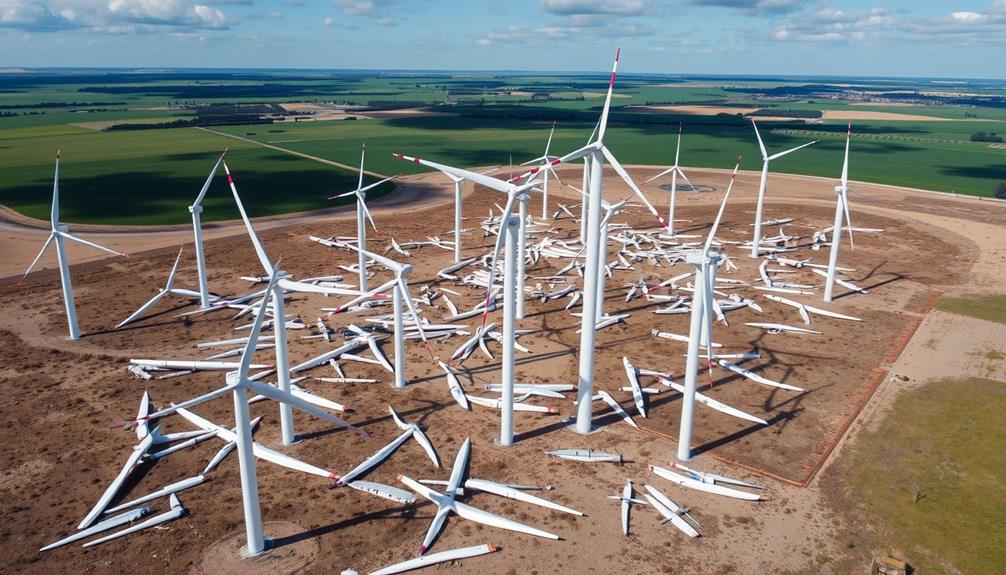
Wind turbine blades are the giants of renewable energy, typically measuring between 150 and 200 feet in length. These impressive structures primarily consist of composite materials, including fiberglass and carbon fiber, which make up about 80-90% of their composition.
While they play an essential role in harnessing wind energy, their eventual decommissioning poses significant challenges. The complexity of these materials means that many conventional recycling methods aren't applicable, highlighting the need for innovative solutions in waste management, such as cold medications overview for improving energy efficiency.
Once their average lifespan of 20-25 years is up, you'll find that retired blades contribute to a growing waste management problem. In 2021, around 8,000 wind turbine blades were retired in the U.S., and projections suggest that by 2050, the cumulative mass of decommissioned blades could reach a staggering 43 million metric tons.
Unlike other components of wind turbines, such as steel and aluminum, which can be recycled, the composite materials in the blades complicate disposal. Currently, only about 15% of wind turbine components are non-recyclable, leaving many blades destined for landfills.
As the demand for wind energy continues to rise, it's important to invest in recycling technologies that can address the disposal issues associated with these massive wind turbine blades.
Lifespan and Decommissioning
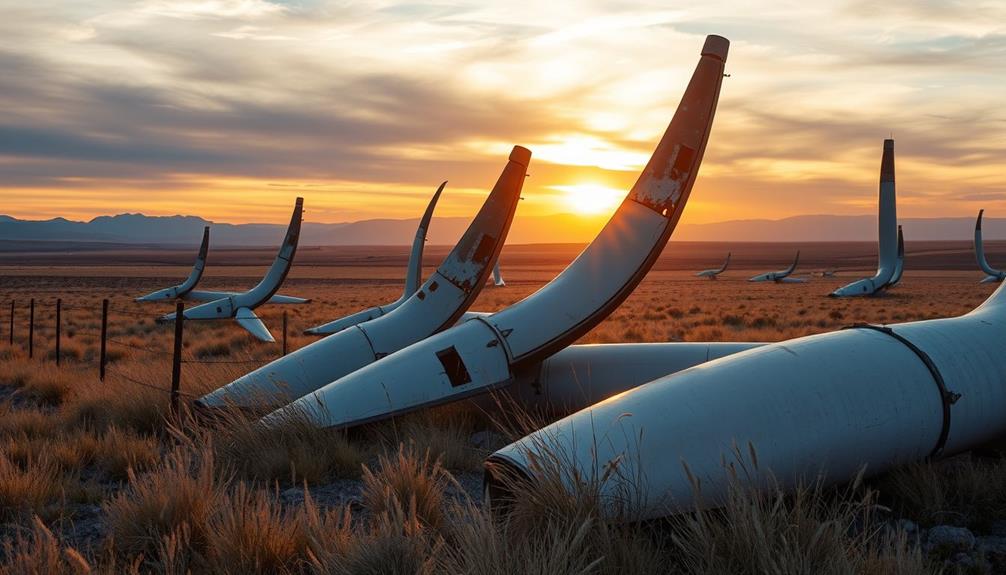
Wind turbine blades usually last between 20 to 25 years, meaning you'll soon see many of them decommissioned.
With the average blade weight ranging from 280 grams to 26 tons, their disposal poses significant challenges due to the composite materials used in their construction.
As more turbines reach the end of their operational life, you'll need to contemplate what happens to the growing number of retired blades, especially in light of the impact on transportation and installation logistics.
Blade Lifespan Overview
Over the next few decades, you'll see that wind turbine blades typically last around 20 to 25 years before they need to be decommissioned. As the demand for wind energy rises, the number of retired wind turbine blades is also increasing. By 2050, experts predict that the cumulative mass of these blades could reach a staggering 43 million metric tons globally.
The materials used in turbine blades, primarily fiberglass and carbon fiber, contribute to their longevity but complicate recycling the blades after their operational life. This durability, while beneficial during use, creates disposal challenges when you consider the sheer volume of blades being retired.
Here's a quick overview of blade lifespan and disposal:
| Stage | Timeframe | Challenges |
|---|---|---|
| Operational Life | 20-25 years | Wear and tear over time |
| Expected Retirements | 3,000-20,000/year | Increasing disposal needs |
| Recycling Efforts | Limited | Difficult materials used |
| Future Projections | 43 million tons by 2050 | Need for better solutions |
Understanding these aspects can help you grasp the significance of managing retired wind turbine blades effectively.
Decommissioning Process Challenges
As the number of decommissioned wind turbine blades rises, the challenges associated with their disposal become more pressing. Wind turbine blades typically have a lifespan of 20-25 years, and as they wear out, the decommissioning process must kick in.
You mightn't realize it, but transporting these massive blades, often exceeding 95 meters in length, poses significant logistical hurdles. Getting them to recycling facilities or landfills isn't straightforward. The complexity of managing these materials parallels the difficulties faced in evaluating Bitcoin IRA suitability, where understanding risks and benefits is essential.
The primary materials used in these blades—composite materials like fiberglass and carbon fiber—complicate recycling efforts. These materials are tough to break down and repurpose, leaving many blades destined for landfills.
With projections indicating that around 1.5 million metric tons of decommissioned blades could accumulate by 2040, the urgency for effective disposal solutions is clear.
As you can see, the increasing energy production and the aging of existing turbines mean tens of thousands of blades will soon reach their end-of-life. It's imperative for industry stakeholders to explore innovative recycling options and develop efficient strategies for the decommissioning process to tackle these mounting challenges head-on.
Recycling Challenges and Solutions
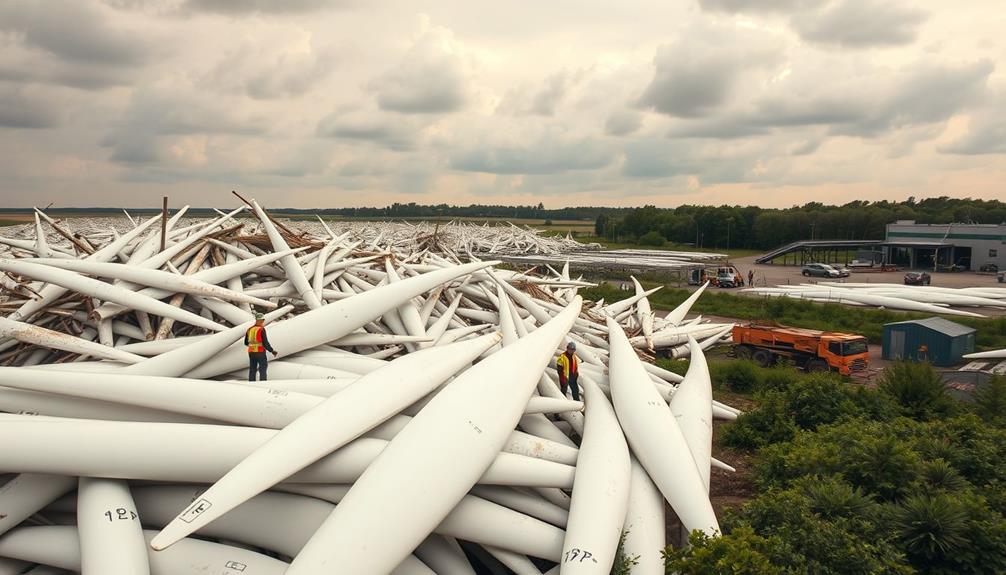
The growing mountain of decommissioned wind turbine blades poses significant recycling challenges that demand immediate attention. With around 8,000 blades decommissioned in the US in 2021 alone, effective recycling solutions are essential for the wind energy industry. To address this pressing issue, research and development into wind turbine blade recycling technologies are urgently needed. This will not only help to reduce the environmental impact of decommissioned blades but also create opportunities for the innovative reuse of materials. The development of cost-effective and environmentally friendly wind turbine blade recycling processes will be crucial for the sustainability of the wind energy industry.
These blades are primarily made of 80-90% composite materials, like fiberglass and carbon fiber, which are notoriously difficult to recycle due to their robust thermoset resins. Additionally, the push for sustainable investment strategies in various sectors, including renewable energy, emphasizes the importance of addressing these recycling issues to promote a greener future investment strategies in precious metals.
Here are some key challenges and potential solutions:
- High Costs: Current recycling technologies are often seen as too expensive, hindering widespread adoption.
- Material Complexity: The composite materials used in blades complicate recycling efforts.
- Innovative Approaches: Companies like Veolia have shown success by recycling blades into cement, cutting carbon emissions.
- Future Developments: Research is underway to create inherently recyclable blade materials, with companies like Siemens Gamesa targeting fully recyclable blades by 2030.
Addressing these challenges is vital for the renewable energy sector.
Innovative Repurposing Ideas
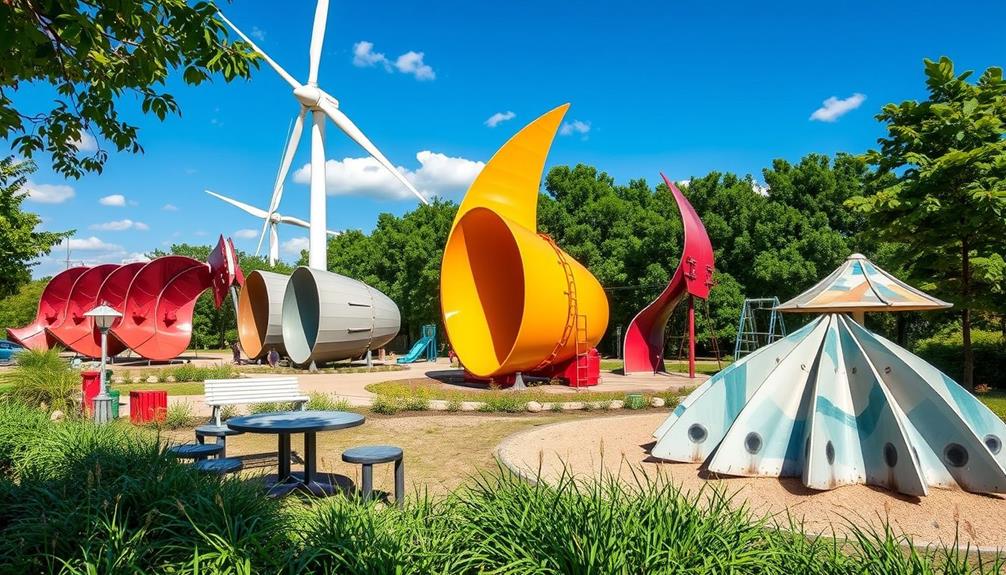
You can turn decommissioned wind turbine blades into exciting playground equipment, creating a safe space for kids to play.
These blades also have potential in architectural design, providing unique features for buildings and public spaces. By utilizing innovative storage solutions, space constraints can be creatively addressed in these designs.
Additionally, think about how they could enhance your garden or landscape, adding both beauty and sustainability to your outdoor areas.
Playground Equipment Transformation
Innovative repurposing ideas are transforming decommissioned wind turbine blades into exciting playground equipment, like slides and climbing structures. Companies like Global Fiberglass Solutions are at the forefront of this movement, turning durable blade materials into fun and safe play structures.
By recycling these blades, they're providing a sustainable alternative to disposal, helping divert waste from landfills. This initiative echoes the rising trend of unique offerings in entrepreneurship that prioritize sustainability and community engagement.
This creative reuse not only contributes to the circular economy but also sparks children's interest in renewable energy and recycling.
Here are a few ways repurposed wind turbine blades enhance playgrounds:
- Unique Designs: Create visually appealing and imaginative structures for kids.
- Educational Value: Teach children about sustainability and renewable energy through play.
- Durability: guarantee long-lasting equipment that can withstand heavy use.
- Community Awareness: Foster a sense of responsibility towards our environment.
Architectural Design Applications
Repurposing decommissioned wind turbine blades for architectural design applications is gaining traction, showcasing creativity and sustainability in construction. You'll find that these innovative reuse projects not only breathe new life into retired materials but also promote sustainable building practices.
For instance, playground equipment crafted from decommissioned blades provides safe, durable recreational spaces for communities, blending fun with environmental responsibility.
Similarly, some projects have turned these robust structures into bicycle shelters, offering weather-resistant storage solutions for cyclists while highlighting the value of recycled blade composites.
Public benches made from used blades serve multiple purposes; they enhance parks and public spaces and raise awareness about renewable energy waste and recycling efforts.
In addition, the Munster Technological University in Ireland has constructed a pedestrian bridge using decommissioned blades, demonstrating their potential as viable building materials in architectural design.
Companies like Global Fiberglass Solutions are also paving the way for future innovations by exploring the creation of new construction materials from these recycled composites, ensuring that decommissioned blades contribute to a more sustainable future.
Every project represents a step toward a circular economy, making architectural design both functional and environmentally friendly.
Garden and Landscape Features
Garden and landscape features made from decommissioned wind turbine blades offer a unique blend of sustainability and creativity.
By repurposing these large, durable structures, you can transform your outdoor space while promoting sustainable use of materials.
The versatility of retired blades allows for innovative creations that enhance both aesthetics and functionality in gardens and public areas, such as unique and wicked planters that incorporate artistic elements.
Consider these exciting ideas for incorporating repurposed turbine blades into your landscape:
- Benches and picnic tables: Perfect for parks or private gardens, providing durable seating.
- Art installations: Collaborate with local artists to create eye-catching sculptures that tell a story.
- Bike shelters: Protect bicycles from the elements while showcasing eco-friendly design.
- Playground equipment: Create unique, sturdy structures that inspire community engagement and outdoor play.
Environmental Implications
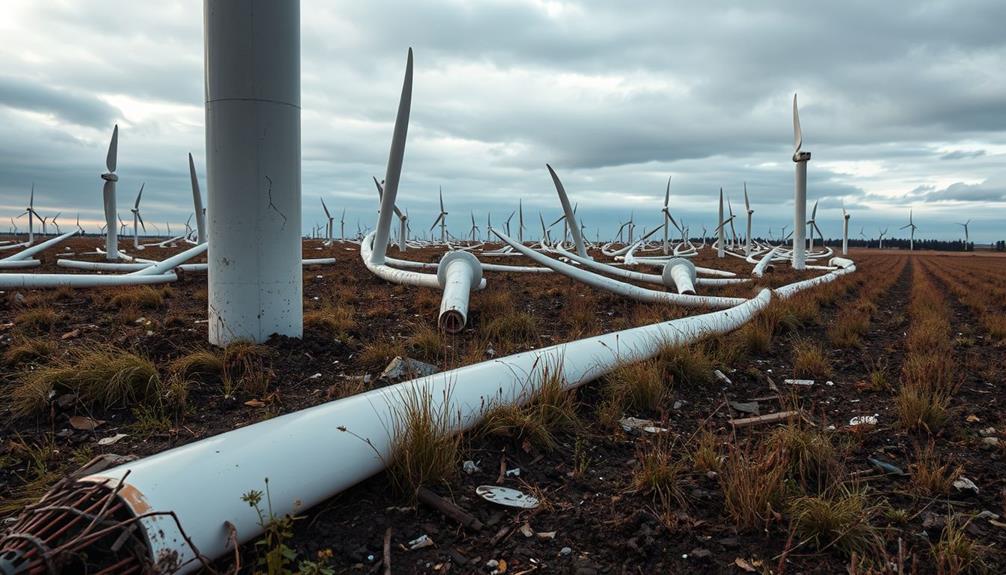
The environmental implications of wind turbine blade disposal are significant and troubling. Wind turbine blades, primarily made of non-biodegradable fiberglass and carbon fiber, can take hundreds of years to decompose. When these blades end up in landfills, like those in Sweetwater, Texas, they contribute to long-term environmental pollution. The risk of harmful chemicals leaching into the soil and groundwater can severely impact local ecosystems, raising alarms about sustainable waste management practices.
Additionally, the growing reliance on renewable energy sources, including wind power, highlights the importance of addressing the lifecycle of all components, including energy-efficient models that may lead to better disposal solutions.
By 2050, we could see around 43 million metric tons of retired wind turbine blades globally, which poses a formidable challenge. Not only do these graveyards affect the landscape's aesthetics, but they also threaten the natural beauty of regions that rely on tourism and outdoor activities.
As we push for renewable energy, we need to evaluate the carbon footprint of the entire wind energy lifecycle, including blade disposal. This situation underscores the urgent need for effective recycling solutions to mitigate environmental pollution and align with sustainability goals.
Without proactive measures, the growing accumulation of wind turbine blades will continue to strain our ecosystems and landscapes.
Regulatory Landscape and Policies
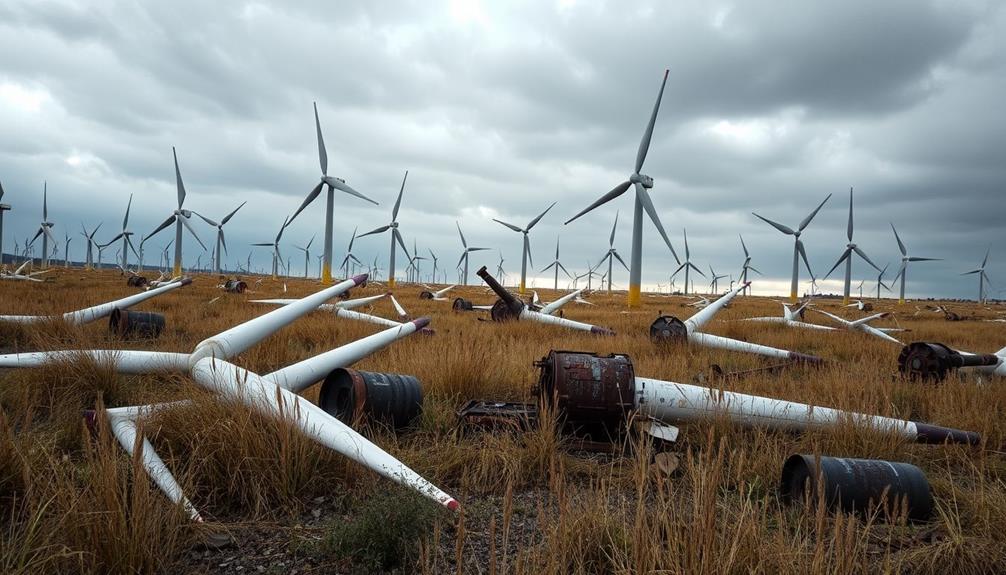
Maneuvering the regulatory landscape for wind turbine blade disposal reveals a complex interplay of policies aimed at addressing environmental concerns. Several European countries, such as Germany and the Netherlands, have enacted bans on landfilling wind turbine blades. This trend is likely to spread, with more countries expected to adopt similar measures by 2025 due to high disposal costs and limited landfill space.
As the focus on content relevance and authority increases, regulatory bodies are recognizing the significance of establishing clear guidelines for waste management in renewable energy sectors.
In the U.S., however, lower disposal costs and ample landfill space create varying incentives for recycling, leading to continued landfilling. Recent fines imposed by the Texas Commission on Environmental Quality on companies like Global Fiberglass Solutions underscore the urgent need for stricter enforcement of environmental policies.
To navigate these challenges, you should be aware of the following key aspects:
- Extended producer responsibility (EPR) policies could motivate wind energy companies to better manage end-of-life processing.
- Advocacy for stricter environmental regulations is increasing, emphasizing the lack of specific guidelines for turbine blade disposal.
- Recycling initiatives are gaining traction, aiming to minimize waste and maximize resource recovery.
- Awareness of the regulatory landscape is essential for ensuring compliance and promoting sustainable practices in wind energy waste management.
Economic Considerations
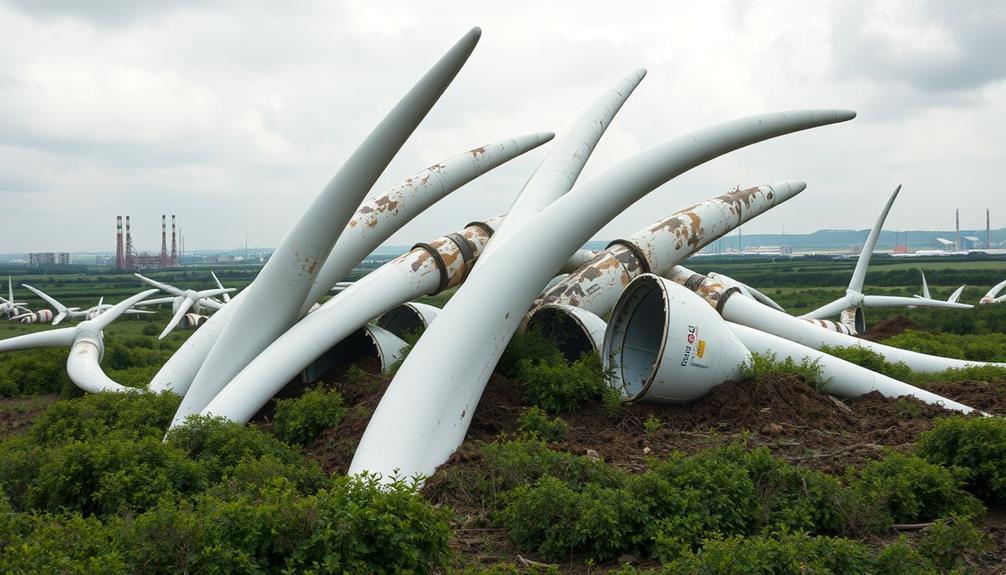
Maneuvering the economic implications of wind turbine blade disposal is essential for companies invested in renewable energy. The cost of disposal can notably impact financial decisions, especially with potential landfill fees climbing higher.
General Electric's recent lawsuit against Global Fiberglass Solutions (GFS) underscores the stakes; GFS failed to deliver promised recycling services despite receiving $16.9 million, and now owes over $1 million in unpaid rent for blade storage. This situation highlights the financial burdens associated with improper waste management.
As companies look to diversify their portfolios and manage risks, exploring alternative investments like Gold IRAs can provide a safe haven during economic uncertainty, offering potential tax advantages and long-term appreciation.
As the global wind power market expands, experts predict that the cumulative mass of decommissioned blades could reach a staggering 43 million metric tons by 2050. This reality demands economic incentives for recycling initiatives, ensuring that companies can manage disposal effectively while minimizing costs.
Additionally, a robust recycling sector could create jobs, addressing both economic and environmental concerns. By investing in innovative recycling methods, companies can't only alleviate financial pressures but also contribute to a sustainable future for wind energy.
Prioritizing economically sound disposal strategies will ultimately bolster the renewables sector and promote environmental stewardship.
Future of Blade Disposal
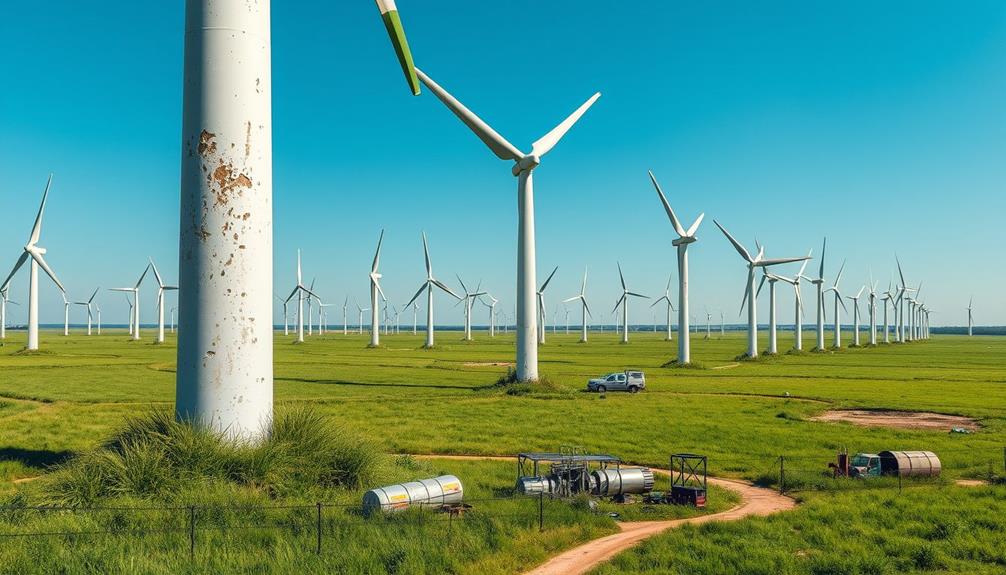
As the wind power industry grows, the future of blade disposal is coming into sharper focus. With the potential for 43 million metric tons of decommissioned blades by 2050, it's essential for you to understand the emerging solutions that could reshape the landscape. Blade manufacturers are prioritizing innovative materials and methods to guarantee sustainability.
Here are some key developments to watch:
- Inherently recyclable blades: Companies like Siemens Gamesa are working towards fully recyclable blades by 2030, utilizing advanced epoxy resin technologies.
- Innovative recycling methods: Repurposing blades for construction materials or using them in cement production can greatly reduce landfill waste.
- Regulatory changes: Several European countries are enacting bans on blade landfilling, pushing for stricter recycling policies to encourage thorough waste management strategies.
- Sustainable supply chains: The focus is shifting towards creating a circular economy in wind energy, prioritizing recyclable blades at every stage.
These advancements show promise not only for the environment but also for the wind energy sector's long-term viability.
Community Impact and Response
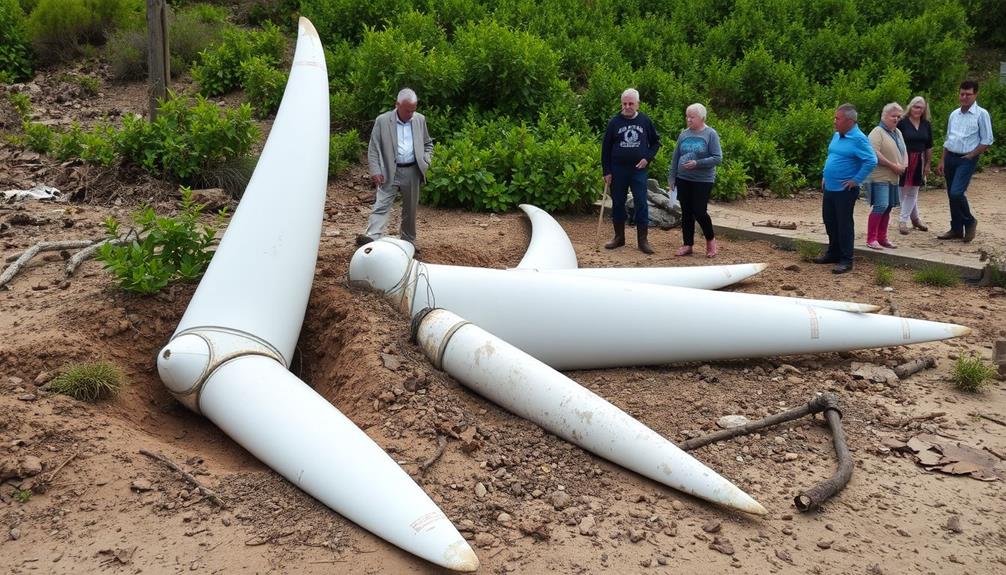
In Sweetwater, Texas, a troubling situation has emerged as discarded wind turbine blades pile up, creating significant community concerns. Since 2017, Global Fiberglass Solutions (GFS) has stockpiled these blades, covering over 30 acres. This not only poses health and safety risks, but also threatens the local economy as residents worry about the town's reputation as a wind-energy hub.
Community leaders are rallying for immediate action to address the issue. They stress the need for effective waste management solutions to alleviate the negative impacts on the quality of life. Concerns about mosquito breeding and safety hazards are at the forefront of these discussions.
Here's a snapshot of the situation:
| Concern | Impact on Community | Response Actions |
|---|---|---|
| Health and Safety | Increased mosquito breeding | Advocate for blade removal |
| Local Economy | Threatened wind-energy reputation | Legal actions against GFS |
| Waste Management | Ineffective disposal methods | Push for sustainable solutions |
The community's voice is critical in shaping the future of Sweetwater, as residents and leaders push for resolution and restoration.
Frequently Asked Questions
Where Do Old Wind Turbine Blades Go?
When old wind turbine blades reach the end of their life, they often end up in landfills. Unfortunately, their size and materials make recycling challenging, leading to environmental concerns and a need for better disposal solutions.
What Is the Lifespan of Wind Turbine Blades?
Wind turbine blades typically last around 20 to 25 years. As they age, you'll notice their efficiency declines, prompting the need for decommissioning. Understanding their lifespan helps you appreciate the importance of sustainable disposal solutions.
How Many Wind Turbine Blades Are in a Landfill?
You'd find thousands of wind turbine blades in landfills across the US and Europe, with estimates suggesting about 8,000 decommissioned blades in the US alone as of 2021. The numbers keep growing annually.
Why Do Old Windmills Have 4 Blades?
You might think more blades always mean better performance, but four-blade windmills enhance stability and capture energy in low winds. Their smoother motion reduces stress, making them ideal for specific environments despite higher costs.
Conclusion
As you ponder the fate of old wind turbine blades, remember that even the mightiest giants eventually yield to time. Just like the phoenix rising from its ashes, innovative solutions are emerging to transform these discarded giants into valuable resources. By embracing recycling and repurposing, you can help turn the blade graveyard into a demonstration of sustainability. Together, we can guarantee that every end is merely a new beginning, forging a greener future for generations to come.
